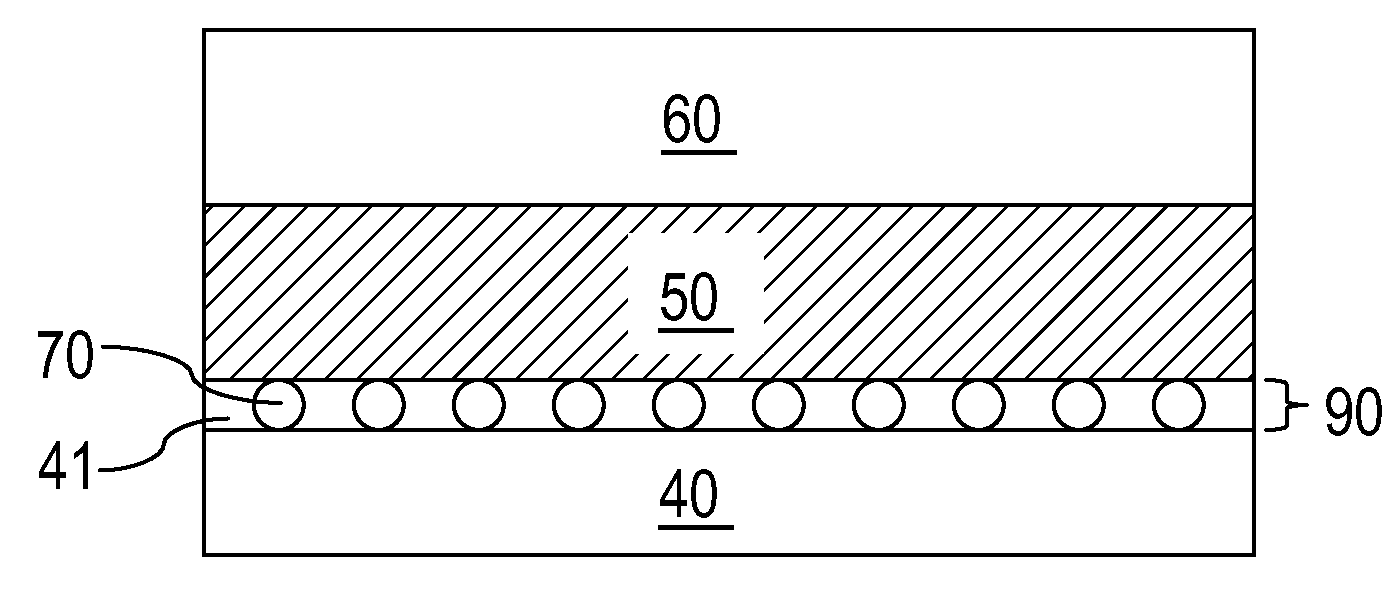Current constricting phase change memory element structure
a phase change memory and current constricting technology, applied in the field of semiconductor structures, can solve the problems of significant variations in the resistance of the mixed phase change material layer, the difficulty of increasing the density of the pcm device, etc., and achieve the effect of reducing the size of the programming transistor
- Summary
- Abstract
- Description
- Claims
- Application Information
AI Technical Summary
Benefits of technology
Problems solved by technology
Method used
Image
Examples
first embodiment
[0052]Sequential cross-sectional views of a first exemplary structure according to the present invention are shown at various stages of a manufacturing process in FIGS. 3A-3F. Referring to FIG. 3A, a bottom conductive plate 40 is formed on an underlying semiconductor structure (not shown). The bottom conductive plate 40 may be formed by chemical vapor deposition or sputtering of a metal layer. Methods of placing the bottom conductive plate 40 in a semiconductor structure for the purpose of forming a PCM memory element is well known in the art. The bottom conductive plate 40 comprises a conductive material that may be, for example, selected from Ti, Ta, W, Mo, Al, Cu, Pt, Ir, La, Ni, Ru, another elemental metal, and alloys thereof. The thickness of the bottom conductive plate 40 is typically in the range from about 10 nm to about 80 nm.
[0053]Referring to FIG. 3B, a monolayer of insulating nanoparticles 70 is applied to a top surface of the bottom conductive plate 40. Each of the insu...
third embodiment
[0074]Referring to FIG. 6C, an insulating layer 80 is formed on the first phase change material layer 51, for example, by chemical vapor deposition. The insulating layer 80 is formed by the same method as and comprises the same material as the insulating layer 80 according to the The thickness of the insulating layer 80 may be from about 3 nm to about 60 nm.
[0075]Referring to FIG. 6D, a monolayer of insulating nanoparticles 70 is applied to a top surface of the insulating layer 80. The same type of insulating nanoparticles 70 may be employed as in the first embodiment. Preferably, the insulating nanoparticles 70 are self-aligning and / or self-planarizing on the top surface of the insulating layer 80. The monolayer of insulating nanoparticles 70 are separated among one another so that gaps are present among the insulating nanoparticles 70 when viewed from above. The gaps may be contiguous or many be disjoined among one another.
[0076]Referring to FIG. 6E, an anisotropic reactive ion e...
seventh embodiment
[0096]Referring to FIG. 9, a seventh exemplary structure according to the present invention comprises a bottom conductive plate 40, a phase change material layer 50, a dielectric layer 77 containing a tapered via hole sidewall 78, a tapered via liner 110 having a liner bottom surface 79, and a conductive via plug 60′. The phase change material layer 50 abuts the bottom conductive plate 40 located underneath, the liner bottom surface 79, and the dielectric layer 77. The tapered via liner 110 abuts the tapered via hole sidewall 78 and contains a monolayer of insulating nanoparticles 70 that are embedded in and separated by a volume 65 of a conductive material. The conductive via plug 60′ comprises the same conducive material as the volume 65 of the conductive material within the tapered via liner 110.
[0097]The bottom conductive plate 40 and the conductive via plug 60′ comprise a conductive material that may be, for example, a material selected from Ti, Ta, W, Mo, Al, Cu, Pt, Ir, La, N...
PUM
 Login to View More
Login to View More Abstract
Description
Claims
Application Information
 Login to View More
Login to View More - R&D
- Intellectual Property
- Life Sciences
- Materials
- Tech Scout
- Unparalleled Data Quality
- Higher Quality Content
- 60% Fewer Hallucinations
Browse by: Latest US Patents, China's latest patents, Technical Efficacy Thesaurus, Application Domain, Technology Topic, Popular Technical Reports.
© 2025 PatSnap. All rights reserved.Legal|Privacy policy|Modern Slavery Act Transparency Statement|Sitemap|About US| Contact US: help@patsnap.com



